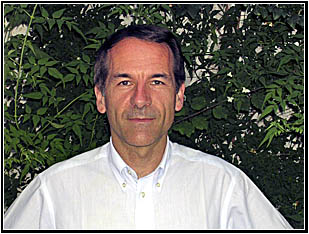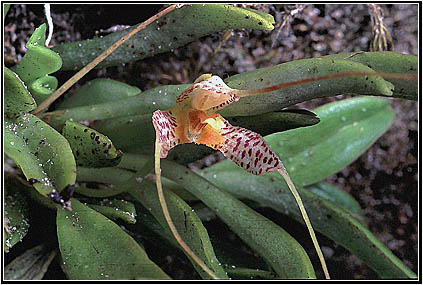|
Interview
with Jean-Michel Hervouet
|
Jean-Michel Hervouet is the vice-president of the SFO (Société
Française d’Orchidophilie) and has published about
20 reports of travels all over the world in the journal «
L’Orchidophile ».
He is a senior research engineer at Electricité de France
and also teaches fluid mechanics.
|
|
 |
ON: Jean-Michel
Hervouet, how long have you studying orchids?
JMH: My first photograph of an Ophrys dates
back to May 1978, I bought my first book to know what species it was,
then a second and 27 years after, I have a large library in my basement,
but it is still not enough.
ON: Have you travel around the world?
JMH: A lot, actually 3 or 4 travels a year, either
for holidays, or taking the opportunity of scientific meetings for my
job. Every spring I visit the Mediterranean coasts or islands, this
year it was Turkey and Portugal, and I do one or two larger trips, like
Madagascar, South-East Asia or America.
ON: You have visited the Mount Roraima which is mainly situated from
Venezuela and goes through Guyana having a part in Brazil. What can
you tell us about this experience?
JMH: It was a long-time dream, visiting the “lost
world” which inspired Arthur Conan Doyle’s book, the more
so because I had also read the book of the late G.C.K. Dunsterville
: “Orchid hunting in the lost world”. Being at the foot
of mount Roraima is an impressive experience, you see those 600 m cliffs
and wonder where the hell can be the way up.
ON: What kind of habitats are the savannah (Gran Sabana) you have visited?
JMH: The habitats at the foot of the tepuis are
a patchwork of rain forests and savannahs. In October and November they
are mostly dry, with only a few orchids. We could spot pseudobulbs of
Catasetum but none was in flower. There are also a few swampy
areas, and this is where Schomburgk discovered the carnivorous plant
Heliamphora nutans, without even climbing Mount Roraima from
where it is said to be endemic.
ON: Can you explain what exactly is a Tepuis?
JMH: The tepuis are high table-lands, generally
surrounded by cliffs, composed of very old Precambrian rocks, in fact
among the oldest rocks on the planet: 1,7 billion years. There are about
a hundred tepuis in the state of Bolivar in Venezuela. The top of Mount
Roraima is covered with very old sandstone where fossil ripples of ancient
lakes are still visible.
ON: The highest waterfall in the world is found there, Salto Angel but
it is not the only one. What could you say about the rivers, waterfalls
and rain system? What is the role they have on the occurrence of orchids?
JMH: When you see the river Kerepacupai jumping
Salto Angel, you realize how large must be the Auyantepui. It is so
large (700 square kilometers) with such big canyons that when approaching
it on rio Carrao you first believe that there are several mountains.
As for Mount Roraima, it is continuously watered by rain, at least every
time strangers step on it, as says a legend. It is obviously a very
convenient place for orchids. From the top of Mount Roraima, you can
see its twin tepui, the Kukenan, with other amazing 600 m waterfalls.
Between Roraima and Kukenan, there is a narrow pass which triggers heavy
rainfalls, due to the low pressure associated with the “Venturi”
effect. It is always obscured by clouds, and must be a very specific
habitat, very rich in orchids.
ON: In general, it is said that this region has two kind of vegetation,
above 1000m the dense Amazon Forest (which is similar to the environment
found in the southeast of Brazil) and ecological refuges found at about
2.500m where is difficult to penetrate and rich in orchidaceae. You
said that the biotypes of tepuis are very poor. What kind of vegetation
is found in region you visited?
JMH: On top of Mount Roraima, you mostly see black
rocks, and small patches of vegetation, carnivorous plants and orchids,
and also a specific family, the Rapateaceae, with the genus Stegolepis
discovered here by Imthurn. We actually found only a few orchids on
the top, compared to the rich flora of the dense forest on the way up.
|
ON:
In what kind of habitat have you found Pleurothallidinae,
a very humid environment? The top of the Mount Roraima
is also covered with moist?
JMH: We found a lot of Pleurothallidinae
near the base camp, especially Pleurothallis fritzii, Myoxanthus
simplicicaulis, Stelis alata, Scaphosepalum breve and Trichosalpinx
memor, close to a small stream where we went to wash.
It was the verge of a dense and dark forest.
However they are so small that you can only spot them if you stop
and look for a while, so we certainly overlooked a lot of them
a the way up.
We also found Masdevallia picturata at the entrance of
a cave on the top, it was a seemingly very dry place but probably
sprayed by rain when wind is blowing, that is to say often.
|

Masdevalia
picturata |
ON: And the Phragmipedium?
JMH: Phragmipedium lindleyanum is clearly
visible at the beginning of the way up to Mount Roraima, together with
Habenaria ernestii. We had seen several in Sierra de Lema, when
driving from Puerto Ordaz, along with Selenipedium steyermarkii
and Brassia bidens.
ON: How many species and genera have you the opportunity to see in there?
JMH: In two weeks we have seen about 75 species
of orchids, it is quite remarkable, we only did similar scores on the
famous Mount Kinabalu in Borneo. A few species remain to identify. For
example we have a mysterious unknown orchid from the top of Roraima.
It seemed to have no leaves and we even have no idea of the genus, if
some of your readers has an idea…
ON: What are your next projects?
JMH: It will be a trip to Madagascar in October
and November 2005, to climb Mount Marojejy which is a very rare and
preserved habitat at the altitude of 2000 m. I would also like to come
back to Brazil and Venezuela, to climb the famous Pico de la Neblina.
This is another long-time dream.
Photos by Jean-Michel
Hervouet
|
Any
kind of reproduction (print, digital or anyone other) of any
type of material of this site - texts, layout, photos, images
and others - is strictly forbidden without previous written
permission by the authors.
|

|